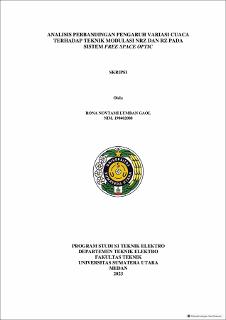| dc.description.abstract | The development of optical fiber communication telecommunication systems used today has weaknesses that can be overcome by the use of Free Space Optic (FSO) systems that do not use optical fiber as a transmission medium but free space. The advantages of FSO are very large bandwidth, short installation time on the network, high data transmission speed and immunity to Electro Magnetic Interface (EMI). The main constraint of FSO is that light propagation is affected by various limitations, especially atmospheric turbulence due to weather and environmental structures. These FSO systems are capable of working at speeds of 1 to 100 Gbps which depends on the wavelength and modulation technique. NRZ and RZ modulation techniques serve to shape the spectrum of digital signals according to the specific communication medium, increase the data rate and synchronize the signal with the receiver. The signal propagation process is related to the weather attenuation of the FSO system. The higher the weather attenuation, the lower the signal quality and the lower the distance range. This thesis will discuss the comparative analysis of the effect of weather variations on NRZ and RZ modulation techniques on the FSO system. Testing using Optisystem 7.0 software by analyzing the Q Factor and BER values of each weather. This research uses 2 schemes, NRZ and RZ, for 4 weather conditions. namely very light mist, very light fog, drizzle, strong rain. The simulation results show that in both test schemes the best simulation in the RZ modulation technique, the Q Factor value in very light mist 38.4317 at a distance of 11 km. The Q Factor value in very light fog 38.4473 at a distance of 3 km. The Q Factor value in drizzling weather 38.374 at a distance of 40 km. The Q Factor value in strong rain 38.3156, which is at a distance of 6 km. | en_US |


